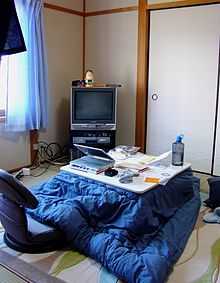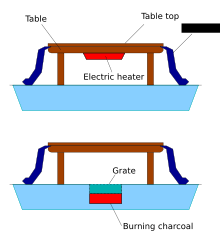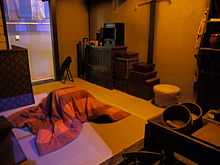Kotatsu





A kotatsu (炬燵) is a low, wooden table frame covered by a futon, or heavy blanket, upon which a table top sits. Underneath is a heat source, often built into the table itself.[1] Kotatsu are used almost exclusively in Japan, although similar devices are used elsewhere.
History
The history of the kotatsu begins in the Muromachi era in the 14th century.[2][3] Its origins begin with the Japanese cooking hearth known as the irori. Charcoal was the primary method of cooking and heating in the traditional Japanese household and was used to heat the irori.[2] By the 14th century in Japan, a seating platform was introduced to the irori and its cooking function became separated from its seating function. On top of the wooden platform a quilt was placed, known as an oki which trapped and localized the heat of the charcoal burner.[4][5] This early ancestor to the modern kotatsu was called a hori-gotatsu. The word hori-gotatsu (掘り炬燵) is derived from the kanji 掘-り (hori) meaning ditch, digging, 炬 (ko) meaning torch or fire, and 燵 (tatsu) meaning foot warmer.[2][6]
The formation of the hori-gotatsu was slightly changed in the Edo Period in the 17th century. These changes consisted of the floor around the irori being dug-out into the ground in a square shape. The wooden platform was placed around this, making a hearth. The blanket was then again placed on top of the platform where one could sit underneath to stay warm.[2]
The moveable kotatsu was later created originating from the concept of hori-gotatsu. This kotatsu came about with the popular use of tatami matting in Japanese homes. Instead of placing the charcoals in the irori, they were placed in an earthen pot which was placed on the tatami making the kotatsu transportable.[2] This more modern style kotatsu is known as the oki-gotatsu. The word oki-gotatsu (置き炬燵) is derived from the kanji 置き (oki) meaning placement, 炬 meaning torch or fire, and 燵 meaning foot warmer.[7]
In the middle of the 20th century charcoal was replaced with electricity as a heating source. Instead of having the moveable earthen pot of charcoals beneath the kotatsu, it was possible to attach an electric heating fixture directly to the frame of the kotatsu. Thus, the kotatsu became completely mobile with electricity and was mainstreamed in the Japanese home.[2][8]
Types
There are two kinds of kotatsu used in Japan today, differing in the configuration and the type of heating:
- Electric: The modern style of kotatsu (oki-gotatsu (置き炬燵)) consists of a table with an electric heater attached to the underside of the table. This evolved from a clay pot with hot coals placed under a table.[2] The kotatsu is usually set on a thin futon, like a throw rug. A second, thicker futon is placed over the kotatsu table, above which the tabletop is placed. The electric heater attached to the underside of the table heats the space under the comforter.
- Charcoal: The more traditional type is a table placed over a recessed floor (hori-gotatsu (掘り炬燵)). The pit is cut into the floor and is about 40 centimeters deep. A charcoal heater is placed somewhere in the pit's floor, walls, or, as in the modern-style kotatsu, attached to the table-frame. There are pit type kotatsu with an electric heater too.
Use
In the 21st century, the kotatsu typically consists of the electric heater attached to the frame, which is no longer limited to wood but may be made of plastic or other materials. Generally, a blanket (or shitagake) is draped over the frame and heater and under the table-top. This first blanket is covered by a second heavier blanket, known as a kotatsu-gake (火燵掛布). Kotatsu-gake are often decorative and can be designed to match home décor.[9] A person sits on the floor or on zabuton cushions with their legs under the table and the blanket draped over the lower body. The kotatsu was designed when people most commonly wore traditional Japanese style clothes, where the heat would enter through the bottom of the robes and exit around the neck, thus heating the entire body.
Most Japanese housing is not insulated to the same degree as a western domicile and do not not have central heating, thus relying primarily on space heating. Heating is expensive because of the lack of insulation and the draftiness of housing. A kotatsu is a relatively inexpensive way to stay warm in the winter, as the futons trap the warm air.[10] Families may choose to concentrate their activity in this one area of the house in order to save on energy costs.[11] In the summer, the blanket may be removed, and the kotatsu can be used as a normal table.
It is possible to sleep under a kotatsu, though unless one is quite short, one's body will not be completely covered. This is generally considered acceptable for naps, but not for overnight sleeping for many reasons: one's body is not completely covered, yielding uneven heating; the table is low, so one may accidentally touch heating elements when moving while asleep, risking burns. Traditionally, children are told that they will catch a cold if they sleep under a kotatsu. However, pets such as cats frequently sleep under kotatsu and are small enough to fit completely underneath – comparable to cats who sleep on floor heating vents in western countries (Japanese homes do not generally have floor heating vents).
During the winter months in Japan, the kotatsu is often the center of domestic life. In the evening family members gather around the kotatsu to enjoy food, television, games and conversation while keeping their bottom half warm. It has been said that, "once under the kotatsu, all of your worries slip away as a familiar warmth takes over and you become completely relaxed."[12]
Other countries
A similar product called a korsi is also used in Iran.
A very similar item called a sandali has been widely used for centuries in Tajikistan and Afghanistan. They are used even today in many traditional houses, as a warm family eating place.[13]
In Spain and Portugal, there is a similar item called a "mesa camilla" which is a small round table with a "brasero" heater placed underneath.
In China and Korea, underfloor heating is traditionally used instead; the devices used are, respectively, a Kang bed-stove and an ondol.
See also
- Chabudai
- Hibachi
- Foot stove, a similar Dutch item
- Korsi, a similar Persian item
References
- ↑ "Find words:kotatsu". Denshi Jisho. Retrieved 23 September 2013.
- ↑ 2.0 2.1 2.2 2.3 2.4 2.5 2.6 kotatsu definition
- ↑ Buckley, Sandra (2002). Encyclopedia of contemporary Japanese culture. New York, NY: Routledge. pp. 267–268.
- ↑ Dunn, Charles (1972). Everyday life in Traditional Japan. Vermont and Japan: Charles E. Tuttle Co. pp. 159–160.
- ↑ Tourist Industry Division Ministry of Transportation (1953). JAPAN The Official Guide. Japan: Japan Travel Bureau. p. 25.
- ↑ "Nihongo 101- horigotatsu". Archived from the original on 2012-04-25. Retrieved 23 September 2013.
- ↑ "Nihongo 101". Archived from the original on 2012-04-25. Retrieved 23 September 2013.
- ↑ "How the Japanese heat their homes in the winter". Retrieved 23 September 2013.
- ↑ http://www.designbyaika.com/introduction-to-kotatsu-kotatsugake/
- ↑ "kotatsu." Encyclopedia of Contemporary Japanese Culture. New York: Routledge, 2002. 267-68. Print.
- ↑ http://www.jstage.jst.go.jp/article/jhes/7/1/7_35/_article
- ↑ "Kotatsu Tables & Accessories". Retrieved 23 September 2013.
- ↑ Jessica Barry. "Afghanistan: Sandali stoves, a blessing and a curse". ICRC. Retrieved 23 September 2013.
| |||||||||||||||||||||||||||||||||||||
